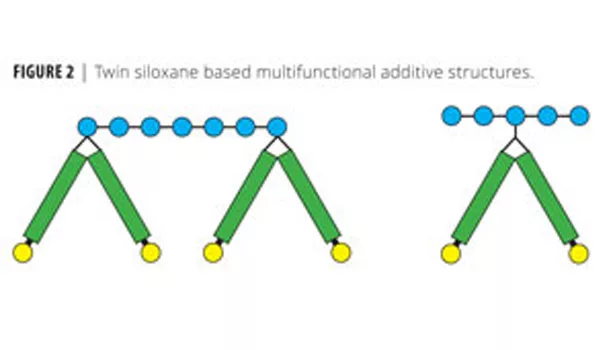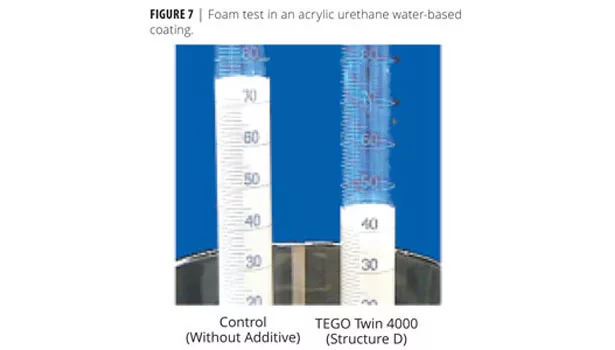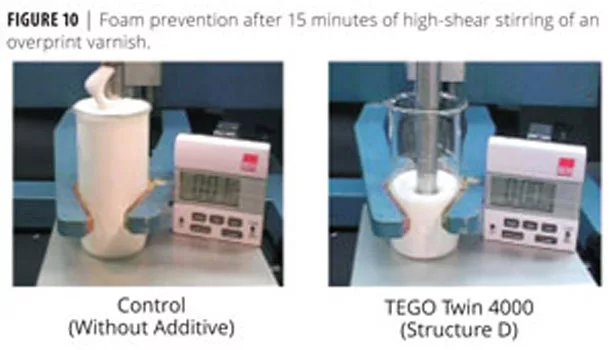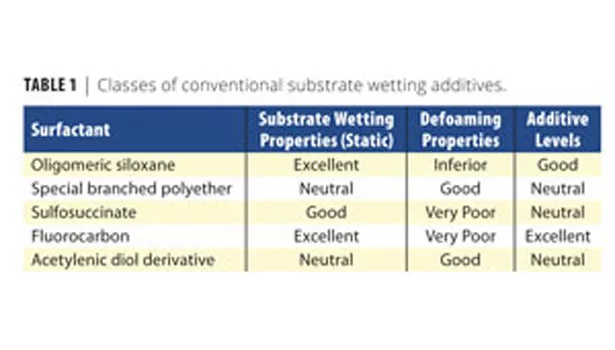Siloxane Based Multifunctional Additives
An Innovative Approach Toward Formulating














The challenges of substrate wetting and flow are especially problematic for formulators of water-based coatings.1-4 Creating a closed, defect-free aqueous coating film is difficult not only on common low-energy substrates like plastics, but also when wetting a high-energy substrate such as metal, since it may not always be clean or free of surface contaminants. Wetting on wood can be critical because wood needs proper penetration into pores and grains, and often contains natural oils.
Substrate wetting additives – special surfactants that modify interfacial tensions – are commonly used to overcome such problems. Generally, they reduce the surface tension of a coating to a homogeneously low level, enabling the coating to wet the substrate successfully. Very strong surface tension reduction is required to achieve satisfactory wetting over oily and greasy contaminants. However, the same substrate wetting additives that dramatically reduce surface tension often cause a significant degree of foam and air entrapment. Through an innovative development in additive technology, a siloxane based multifunctional approach can now achieve surface tension reduction while providing a defoaming effect.
Existing Additive Technologies
Many different technologies5,6 are used to supply the coating and ink industries with effective substrate wetting additives. As seen in Table 1, different property profiles make the various classes more or less suitable for diverse applications.
Some of these additives provide very strong surface tension reduction, enabling substrate wetting even on contaminated substrates. At higher addition levels they also tend to stabilize foam. This is especially true for fluorocarbon surfactants, but may, to a lesser degree, also apply to siloxane based surfactants. There are some organic surfactants that show hardly any foaming or are even slightly defoaming. However, these are not very effective surface tension reducers and tend to fail when applied to very low-energy substrates or contaminated ones.
As with most additives, usage level is critical. When considering the degree of surface tension reduction needed, effectiveness at low usage levels must also be considered. An additive that is effective at low usage levels is ideal both with regard to cost benefit ratio as well as successful creation of a defect-free coating film.
Development of a Defoaming and Highly Surface-Active Substrate-Wetting Additive
When discussing targets for development, Evonik’s team considered the following criteria most important:
• Providing strong surface tension reduction for good substrate wetting;
• Being effective at very low addition levels;
• Providing a distinct defoaming or foam-neutral effect in most water-based coatings;
• Being ecologically friendly.
The development team knew that siloxane based surfactants could provide strong reduction of surface tension. Studying literature about surfactant behavior, it found that “Gemini” structures, discussed by Fredric Menger8 in 1991, can show high effectiveness at very low levels and potentially contribute to low foaming properties.9,10 The selection of relatively hydrophobic structures suggested additional defoaming properties.
As a result, the idea of a multifunctional additive based on a combination of siloxane and Gemini technology was developed. This combination allowed for dramatic surface tension reduction while also aiding defoaming and avoiding air entrapment. As such, Evonik’s “Twin” technology was born.
When selecting potential raw materials and resulting structures, the team paid particular attention to the structure’s ecological impact, such as water pollution. Developing a molecule with minimal to no influence on the VOC of the finished coating system was also important.
Selecting the Right Structure
Gemini surfactants in literature are also called bis- or double-tailed surfactants.7,8,10 They are characterized by at least two hydrophobic chains, two ionic or polar groups, and the presence of a spacer. The spacer can be of various chemical natures, such as a simple alkyl chain, a polyoxyalkylene segment or an aromatic unit. Most Gemini surfactants are symmetrical structures, as shown in Figure 1.
Compared to conventional surfactants, Gemini types display very different aggregation behavior. This results in significantly lower critical micelle concentration (CMC) and far higher surface activity (a factor up to 100x/1000x), making them quite efficient.11-13 Depending on their structure, they can also significantly reduce foam stabilization.
By combining different in-house technologies, Evonik’s team was able to synthesize structures of the Twin siloxane based multifunctional additives for evaluation, as shown in Figure 2.
Varying the structural parameters, the nature of the polar groups and the overall molecular weight, several different species were obtained that displayed distinctly different performance. For screening purposes, all structures were tested in multiple water-based resins for desired properties. Table 2 summarizes the variety of performance obtained.
It is clear that Structure D and Structure E provided specific properties that perfectly matched the team’s original criteria. Structures D and E were selected for the basis of this experiment as the optimal molecules for further evaluation.
Initial Test Results
Comparing the characteristics of this additive group with existing technologies produced impressive data that underline the special behavior of this new Twin technology. The siloxane based multifunctional additives D and E show very low critical micelle concentration as well as the lowest static surface tension readings of all surfactants tested (Table 3).
However, this data is suitable only for characterizing the additive’s behavior when it is the only ingredient in water. To be an effective substrate wetting agent in coatings formulations requires that the additive show the same properties in the presence of other surface-active ingredients, such as an emulsifier or dispersing agent. This is especially true since some of the tested additives, including the Twin siloxane based multifunctional types, are hydrophobic and not homogenously soluble in pure water. What ultimately matters is performance in a practical application.
Surface Tension Measurements
Comparing the surface tension reduction of both siloxane based multifunctional additive structures to other commercially available substrate wetting additives clearly demonstrates how effective they are. As seen in Figure 3, the siloxane based multifunctional additives D and E provide an exceptionally strong reduction of static surface tension throughout a range of water-based coatings (measured at an addition level of 0.2% surfactant by the DuNouy ring method). Yet, because every resin and coating system performs differently, it was important to capture data from a variety of test formulations. In all five coating systems, both siloxane based multifunctional additives reduced static surface tension significantly better than the other competitive additive systems.
As discussed previously, effectiveness at low addition levels is very important for both the cost benefit ratio as well as achievement of a defect-free coating film. At different addition levels, the extreme effectiveness becomes even more obvious. The tested siloxane based multifunctional additives already create a very strong surface tension reduction at addition levels below 0.1%, as shown in Figure 4. Multifunctional TEGO® Twin 4000 (Structure D) produces a slightly lower static surface tension than multifunctional TEGO Twin 4100 (Structure E). In addition, these siloxane based multifunctional structures improve wetting properties in a variety of application tests and spray methods.
Wetting Properties
For spray application, the coating should ideally form a closed film at low film thicknesses. This ensures a defect-free film and maximizes the application window of the coating. Formulators can achieve this result by using a substrate wetting additive that ensures fine atomization at the spray nozzle and good wetting of coating droplets upon hitting the substrate surface.
Interesting results were obtained with spray robot application of a metallic topcoat on filler-coated panels at a very low film thickness (approx. 15 µm dry) (Figure 5). As demonstrated in the photomicrographs, TEGO Twin 4000 (Structure D) created a completely closed film at very low film thickness. It is important to note that this closed film was achieved with very low usage levels of the siloxane based multifunctional additive. This system used only 0.1% of this novel additive structure as compared to other candidate products. Although not shown, the siloxane based multifunctional additive TEGO Twin 4100 (Structure E) also had excellent wetting and a closed film.
Figure 6 illustrates the excellent wetting properties of the twin structures compared to a conventional siloxane for a water-based flexo ink.
Defoaming Properties
A quick test to demonstrate foaming properties of a coating is the Tego standard stir test. In this test, 50 g of coating are stirred at 3000 rpm for 1 minute by a 3 cm dissolver blade. Immediately after mixing, 45 g of coating are poured into a graduated cylinder and the volume is read. Lower volume reading results in less foam that has been entrained. Performing this stir test with a water-based wood coating based on an acrylic urethane emulsion produced impressive results. The control without any additives had a reading of 76 mL/45 g, whereas the sample containing 0.1% of TEGO Twin 4000 (Structure D) had a reading of 46 mL/45 g (Figure 7). Considering the density of the formulation, it was nearly foam-free.
As shown in Figure 8, the siloxane based multifunctional additive TEGO Twin 4000 (Structure D) provided effective foam prevention at low usage levels. As performed with previous formulations, this one was also tested in a variety of coatings systems. The chart displays TEGO Twin 4000 influence on the foaming behavior of various water-based coatings in comparison with additive TEGO Twin 4100 (Structure E), an oligomeric classical siloxane surfactant, an acetylenic diol derivative, and an organic Gemini surfactant.
TEGO Twin 4000 (Structure D) performs quite well in all five water-based coatings systems. Similar to the previous testing in Figure 3, the additive usage level was 0.2%. As shown in Figure 8, some additive types actually contributed to more foaming than occurred in the control, which had no additive at all. This once again illustrates the need for a multifunctional additive that not only lowers static surface tension but also possesses a defoaming to foam-neutral mechanism. Although the siloxane based multifunctional additive TEGO Twin 4100 (Structure E) possessed slightly weaker defoaming ability, it was either foam-neutral or foam-stabilizing in all coatings systems tested.
Figure 9 compares the defoaming effect of the Twin 4000 (Structure D) compared to an oligomeric siloxane in a urethane wood coating spray application.
Another interesting property with regard to foaming is the much faster foam break-down that could be observed in water-based coatings and inks containing either TEGO Twin 4000 or the TEGO Twin 4100 formulation (Figure 10).
Figure 11 illustrates complete wetting when using TEGO Twin 4100 (Structure E) compared to an acetylenic diol.
Summary
We can state that TEGO Twin 4000 (Structure D) significantly reduces the build-up of macro- and microfoam, and speeds up the foam-break and deaeration in water-based coatings and inks. Siloxane based multifunctional additives have been successfully introduced in the market. Surface defects were rarely obtained and those occurred only in a few formulations with very low solids content. TEGO Twin 4000 (Structure D) has greater defoaming efficiency than TEGO Twin 4100 (Structure E) due to its more hydrophobic nature. However, TEGO Twin 4100 (Structure E) has superior substrate wetting while creating a defoaming or foam-neutral environment.
To evaluate these additives, Evonik highly recommends adding these products without any other substrate wetting additive and defoamer. Further addition of defoamer either may or may not be necessary. When using one of these siloxane based multifunctional additives, an overall reduced additive amount in the coating or printing ink formulation can be expected due to the “two-in-one” character of this additive class.
Initial tests in energy-curable and somewhat polar solvent-based coatings indicate that the siloxane based multifunctional additives act as amphiphilic surfactants in these formulations as well. Even though the surface tension reduction is significantly lower than in water-based formulations, it contributes to improved substrate wetting and flow characteristics.
Additional advantages of this innovative surfactant are its good ecological qualities. The product is free of organic solvent additions and therefore, will have minimal contribution to the VOC of the coating system.
Conclusion
The tested siloxane based multifunctional additives each combine very high surface activity, good substrate wetting and effective defoaming in one molecule. It is most promising for water-based formulations that would normally require both a substrate wetting additive and a defoamer. The testing isolated two unique molecules that provide a multifunctional, “two-in-one” property profile. TEGO Twin 4000 (Structure D) provides both good substrate wetting and high defoaming efficiency. TEGO Twin 4100 provides superior substrate wetting while creating a defoaming or foam-neutral environment.
With this unique and patented technology, property profiles can be obtained that were impossible to achieve with any conventional technology. It is highly probable that this innovative siloxane multifunctional technology will enable us to develop further powerful additives with unique property profiles.
References
1 Freedonia, Phaenomen Farbe 4 2001.
2 Monteny, J.P. Farbe & Lack4 2002, 18.
3 Koenig, G. and Lazerme, P., Farbe & Lack11 2002, 76-82.
4 Streitberger, H.J. and Goldschmidt, A. Besser Lackieren 19 2002.
5 Dorfler, H.D. Grenzflaechen und kolloid-disperse Systeme, Springer-Verlag Berlin Heidelberg 2002, 329-340, 368-371.
6 Ingenieurbüro Kern, Das Wasser, Infos zu Tensiden www.spiralex.de.
7 Kim, Y.K. Dissertation an der Universität Freiburg/Breisgau, 2001.
8 Menger, F.M. and Littau, C.A. J. Am. Chem. Soc.1991, 113, 1451-1452.
9 Castro, M.J.L.; Kovensky, J. and Cirellie, A.F. Tetrahedron Letters 1997, 38, 3995-3998.
10 Rosen, M.J. and Lio, L. JAOCS 1996, 73, 885-890.
11 Pestman, J.M.; Terpstra, K.R.; Stuart, M.C.A.; Van Doren, H.A.; Brisson, A.; Kellogg, R.M.; and Engberts, J.B.F.N. Langmuir 1997, 13, 6857-6860.
12 Rnouf, P.; Mioskowski, C.; and Lebeau, L. Tetrahedron Letters 1998, 39, 1357-1360.
13 Menger, F.M. and Keiper, J.S. Angew. Chem. 112 (200), 1980-1996.
Looking for a reprint of this article?
From high-res PDFs to custom plaques, order your copy today!





